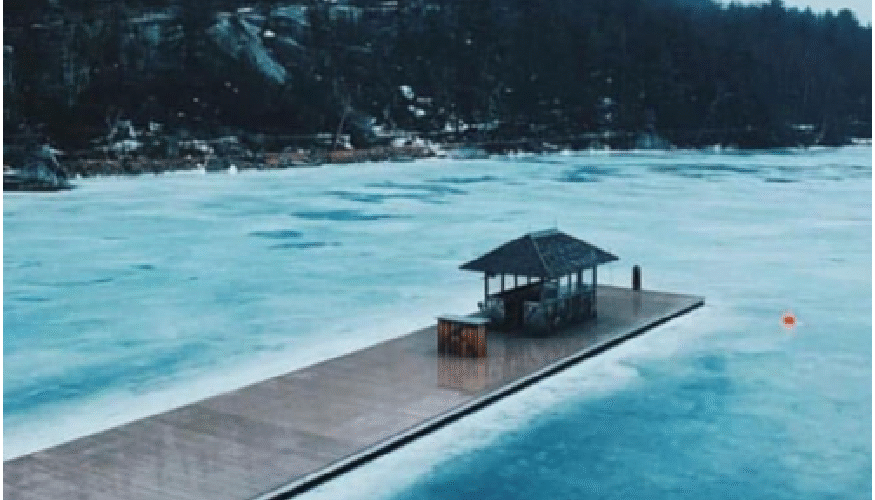A floating dock is a popular feature for waterfront property owners, since it allows easy access to kayaks and boats, among other recreational activities. The question of whether or not you can leave your dock floating on the water during the winter months is becoming more important as winter approaches. The answer depends on many factors, including the type of dock you have installed, the climate in your area and where it was placed. Let’s examine the most important considerations for winterizing and protecting your dock from harsh seasonal elements.
1. Understanding Winter Conditions with Floating Docks
The floating dock can be adjusted to suit the changing water levels. The buoyancy of floating docks is what gives them stability, as opposed to docks that have been anchored into the ground. Floating docks are very durable but can be at risk from conditions such as freezing temperatures, ice accumulation, and strong currents.
Take into consideration the following factors:
- Climate and Temperature: A floating dock is not likely to pose significant risks in areas with mild winters. Ice movement and expansion in areas where water freezes can cause serious damage.
- Ice formation: As the ice moves and expands, it can exert a great deal of force on a dock. This pressure can cause anchor points to crack or warp.
- Wave action and water levels: Storms, high winds and other weather conditions can cause additional stress on a dock during the winter.
2. RisquesOf Leaving A Floating Dock in the Water During Winter
A floating dock that is left in the water for the winter can be damaged. Here are some of the most common risks:
A. A.
The expansion and movement of ice can cause damage to docks. Ice exerts immense pressure and can damage docks.
- Decking and frame damage
- The floats can warp or crack.
- Anchor lines and moorings become loose or break
B. Dock Instability and Displacement
Winter storms, changing water levels and many other factors can cause docks to be dislodged or detached from the anchoring system. Ice and snow can cause the dock to float or submerge.
C. Increased wear
The dock materials can be damaged by exposure to freezing temperatures and ice expansion.
- Deterioration of flotation materials
- If your decking is split or cracked, it can be made from wood or composite.
- Corrosion metal components
3. Protecting your Floating Dock During the Winter
If you live in an area that experiences harsh winters, it’s vital to protect your dock. Here are some tips on how to winterize your floating dock.
Dock A: Store and remove the dock
It is best to remove your floating dock from the water during winter. Dock systems are easily disassembled, and can be transported as they are modular. Store your dock properly to extend its life.
B. Use a dock de-icer
Installing a dock de-icer will help prevent ice build-up around your dock. De-icers circulate the water around your dock to stop it from freezing.
C. Adjust Anchoring and Mooring Systems
The anchoring system can be adjusted to accommodate for any changes in water or ice. Docks are able to move in response to changing conditions thanks flexible mooring system, ice resistant pilings, and other modifications.
D. Elevate dock above water level
Dock owners can raise their docks over the iceline using lifting mechanisms and floating adjustment. This can maintain dock integrity while minimizing exposure to moving ice.
E. Inspect and maintain the dock before Winter
Before winter sets in, perform a thorough inspection of the dock to identify potential weak points. These are the key steps to maintenance:
- Check for loose connections and secure loose hardware
- Inspection of flotation components for cracks and leaks
- Protective coatings for wooden or metal components
- Avoid damage by removing accessories such as bumpers, dock cleats or ladders.
4. When can you leave a floating dock in the water for a period of time?
You may be able to leave your dock floating in water during the winter. If you meet certain criteria, it may be possible to leave your dock in the water over winter.
- The water bodies don’t completely freeze, preventing ice damage.
- The dock is located in a place that is protected from wind and waves.
- The dock is equipped with a deicer, or other protective mechanism.
- The anchoring system is designed to resist seasonal variations.
To avoid unexpected damage, it is essential to regularly monitor the docks throughout the winter.
5. Can you leave your floating dock on the water during the winter?
Your dock’s decision to float in the water during winter depends on many environmental and structural aspects. Docks can survive mild winters if they are properly protected. Docks in areas prone to extreme temperatures and ice formation need to be de-iced, or even removed.
Take the necessary precautions to ensure that your dock lasts longer and costs less to maintain. If you are unsure how to best approach your dock, consult a floating dock expert. You can make an informed choice that’s tailored to your dock.
This post was written by a professional at Supreme Marine Floating Docks. https://supremefloatingdocks.com/ is dedicated to providing top-quality floating docks and marine accessories that combine durability, innovation, and superior performance. While we are a new brand, our team brings over 50 years of combined industry experience, making us a trusted name in the marine world. We are passionate about designing and delivering products that meet the highest standards, ensuring reliability and longevity in all marine environments. Whether for residential, commercial, or recreational use, our docks are crafted with precision and care, setting a new benchmark in the industry. At Supreme Marine, we don’t just build docks—we create lasting solutions.

